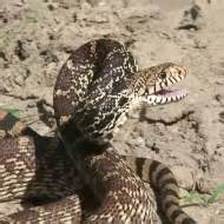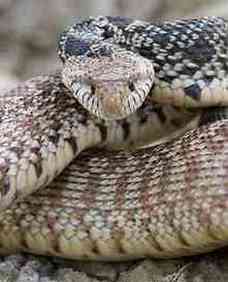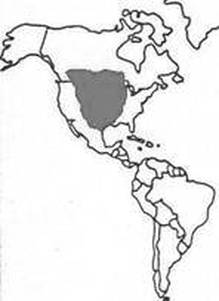BullsnakePituophis catenifer sayi |

Custom Search
|
|
The Bullsnake (Pituophis catenifer sayi) is a large non-venomous snake currently considered a subspecies of the gopher snake (Pituophis catenifer). It's why in the western United States these snakes are often called gopher snakes.
Their range is massive, and the bullsnake can be found from Canada south to Texas and northeast Mexico, and throughout the central United States west to Colorado and east to Illinois. In Canada, they are found throughout Saskatchewan, Alberta, and the desert regions of British Columbia while in Mexico the bullsnake is found in Chihuahua, Nuevo León, Coahuila, and Tamaulipas The species preferred habitat are open prairies, sand prairies, grassy plains and prairies, sandy semi-desert cactus forests, bluff lands, open grassy meadows bordered by woodland and also wheat fields. Generally, the bullsnake prefers loose, sandy soil that allows for easy burrowing. For that reason, bullsnakes also have an enlarged nose shield suitable for digging. The bullsnake is usually more active by day, but during hot weather, they may become more active in the evening and nighttime. The larger bullsnake specimens are quite bulky for a colubrid snake species, their size makes them one of the largest snakes found in Canada and the USA. Even though bull snakes aren't as long as indigo snakes or as heavy or large in diameter as rattlesnakes like the eastern diamondback rattlesnake (Crotalus adamanteus).

An adult bullsnake averages about 4 to 6 feet (1.2 to 1.8 m) in total length, but specimens up to 8 feet (2.5 m) have been recorded. Their average weight ranges from 2.2 to 3.3 lb (1 to 1.5 kg), although heavier specimens can reach 7.9 to 9.9 lb (3.5 to 4.5 kg).
Although the bullsnake can be found in a variety of colorations including albino specimens, their usual coloration is a yellowish brown or creamy body, with black, brown, whitish or even reddish blotches. The pattern consists of larger blotches on top, 3 sets of spots on the sides, and black bands of on the tail. The bullsnake retires into winter dormancy in October and emerges from hibernation in April. They may hibernate alone or with garter snakes, hognose snakes, racers, timber rattlesnakes, milk snakes or other bullsnakes in mammal burrows or rock crevices. Bullsnake predators include carnivorous birds like hawks or eagles, and mammals. While young snakes may also be eaten by larger snakes, raptors and skunks. The species average lifespan is about 12 to 25 years. If feeling threatened they will hiss loudly while vibrating their tail, because of that behavior the bullsnake is frequently mistaken for a rattlesnake, and may even bite, but they aren't venomous. They do resemble the western diamondback rattler (Crotalus atrox), which is also common within their range. Bullsnakes will make great pets once they get accustomed to being handled. Their subspecific name, "sayi", was given in honor of Thomas Say an American naturalist. Diet / Feeding The bullsnake feeds mainly on small mammals, such as mice, rats, pocket gophers, ground squirrels, shrews, rabbits, frogs, as well as ground nesting birds and their eggs and lizards. The juvenile snakes depend mostly on small lizards, frogs, and baby mice. These are powerful snakes that kill larger prey by constriction and will simply swallow smaller prey alive. The idea that the bullsnake on occasion eats rattlesnakes is sometimes given as a reason not to harm them, although a better reason would be their role in controlling warm-blooded vermin such as rodents. Reproduction The bullsnake breeding season occurs in the months of March or April, depending on the location. They usually lay the eggs in the months of April, May or June, depending on the of time of the breeding. They are an oviparous snake species, the female will lay an average of 12 large eggs in burrows excavated in sand or loose soil, beneath large rocks or logs, or small mammal burrows. The female leaves the eggs to incubate unprotected. Clutches ranging from 5 up to 22 eggs have been recorded. The eggs are leathery and rough and are about are 3.5 to 4 inches long with an elliptical shape. The eggs will typically hatch in August or September and the hatchlings are about 8 to 18 in long (20–46 cm) with a grayish color, that remains until their first shed. Conservation / Threats The bullsnake is listed as "Least Concern" species by the IUCN, regarding its presumed large population size with many sub-populations and extensive range. No major threats are believed to exist for the species. Even so, the bullsnake is considered a species of special concern in Iowa. Although the bullsnake is not considered endangered, but the species future could be in trouble because of habitat loss and degradation. Roadkill is also a problem, when they are forced to cross roads, often their journey ends there.
|
Did You Know?
Beside the longest fangs the highly venomous gaboon viper as also the largest venom glands. Scientific Classification |
© 2014 Snake Facts About Us | Privacy Policy | Contact




